Citroen C5 2017 (RD/TD) / 2.G User Guide
Manufacturer: CITROEN, Model Year: 2017, Model line: C5, Model: Citroen C5 2017 (RD/TD) / 2.GPages: 348, PDF Size: 10.72 MB
Page 11 of 348
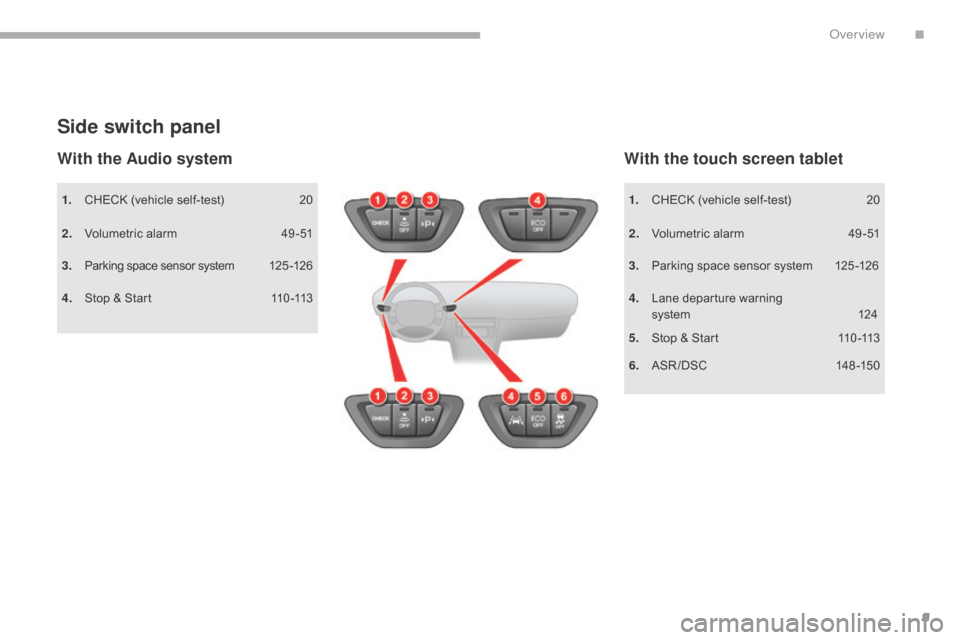
9
C5_en_Chap00b_vue-ensemble_ed01-2016
1. CHECK (vehicle self-test) 2 0
2.
V
olumetric alarm
4
9 -51
3.
P
arking space sensor system
1
25 -12 6
Side switch panel
4. Stop & Start 1 10 -113
With the touch screen tablet
1. CHECK (vehicle self-test) 2 0
2.
V
olumetric alarm
4
9 -51
3.
P
arking space sensor system
1
25 -126
4.
L
ane departure warning
system
1
24
5.
S
top & Start
1
10 -113
6.
AS
R/DSC
1
48-150
With the Audio system
.
Over view
Page 12 of 348
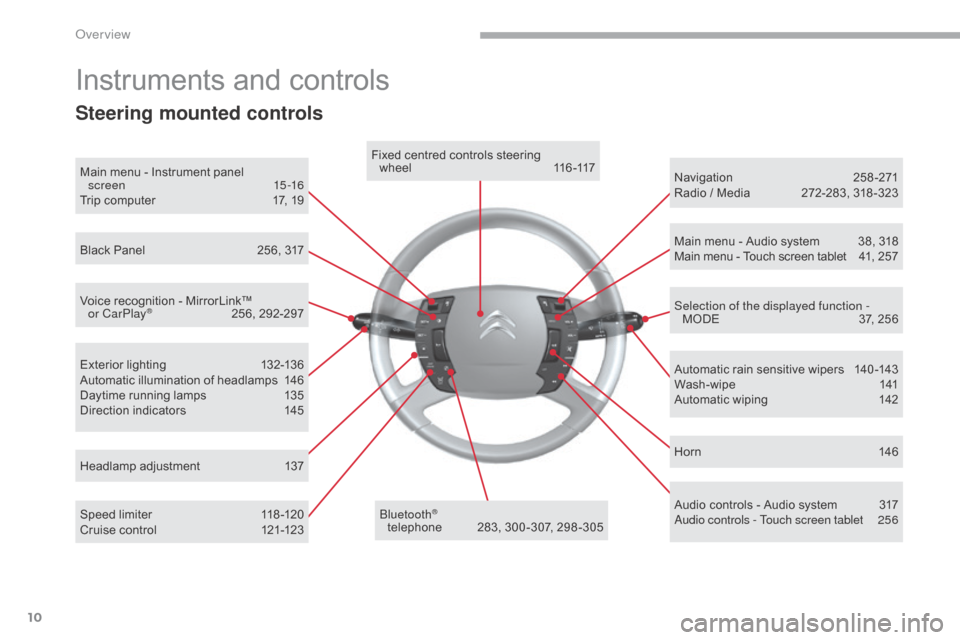
10
C5_en_Chap00b_vue-ensemble_ed01-2016
Exterior lighting 132-136
Automatic illumination of headlamps 1 46
Daytime running lamps
1
35
Direction indicators
1
45
Instruments and controls
Speed limiter 118-120
Cruise control 1 21-123 Automatic rain sensitive wipers
1
40 -143
Wash-wipe
1
41
Automatic wiping
1
42
Headlamp adjustment
1
37
Main menu - Instrument panel
screen
15-16
Trip computer
1
7, 19
Fixed centred controls steering
w h e e l
11
6 -117
Bluetooth®
telephone 2 83, 300 -307, 298 -305 Hor n
14
6
Navigation
2
58-271
Radio / Media
2
72-283, 318 -323
Selection of the displayed function - MODE
3
7, 256
Main menu - Audio system
3
8, 318
Main menu - Touch screen tablet
4
1, 257
Voice recognition - MirrorLink™ or CarPlay
® 2 56, 292-297
Black Panel
2
56, 317
Audio controls - Audio system
3
17
Audio controls - Touch screen tablet
2
56
Steering mounted controls
Over view
Page 13 of 348

11
C5_en_Chap00b_vue-ensemble_ed01-2016
Technical data - Maintenance
Petrol engines 241
Petrol weights 2 42
Diesel engines
2
43
Diesel weights
2
44
Dimensions (Saloon)
2
45-246
Dimensions (Tourer)
2
47-248
Identification markings
2
49
Opening the bonnet
1
85
Petrol under-bonnet layout
1
86
Diesel under-bonnet layout
1
87
Running out of fuel - Diesel
2
03
Checking the levels
1
88 -191
-
oil
-
brake fluid
-
power steering fluid
-
coolant
-
screenwash / headlamp wash fluid
Ad
Blue
® 19 5 -202
Very cold climate protection
1
83
Changing bulbs
2
18-228
-
front
-
rear
-
interior Checking components
1
92-194
- battery
-
air / passenger compartment filter
-
oil filter
-
particle filter (Diesel)
-
brake pads / discs
B
attery
2
35 -238
Energy economy mode
1
79
Engine compartment
fuses
2
29, 233 -234
.
Over view
Page 14 of 348
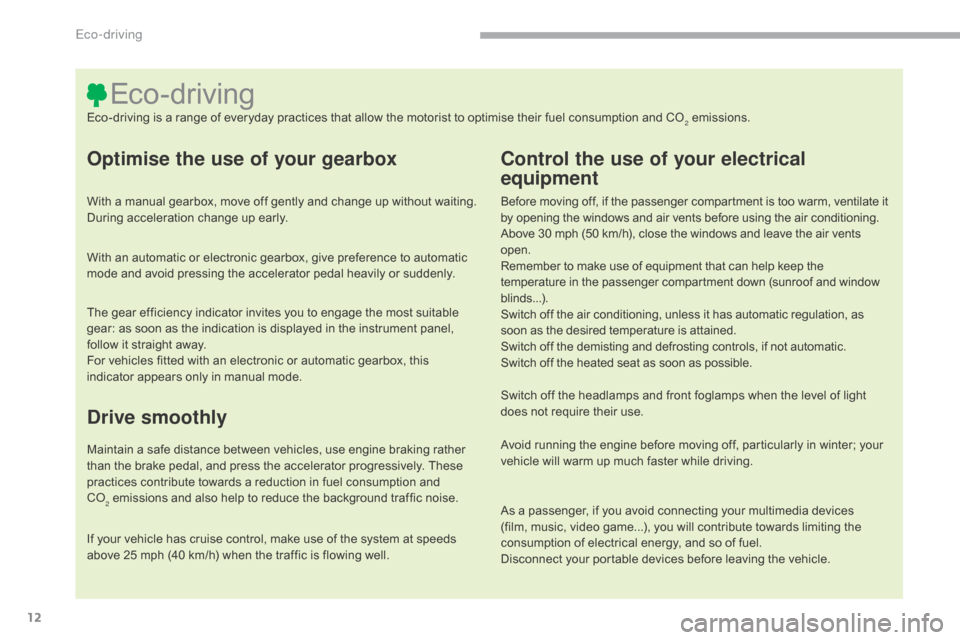
12
C5_EN_CHAP00C_ECO-CONDUITE_ED01-2016.
Optimise the use of your gearbox
With a manual gearbox, move off gently and change up without waiting.
During acceleration change up early.
With an automatic or electronic gearbox, give preference to automatic
mode and avoid pressing the accelerator pedal heavily or suddenly.
Control the use of your electrical
equipment
Before moving off, if the passenger compartment is too warm, ventilate it
by opening the windows and air vents before using the air conditioning.
Above 30 mph (50 km/h), close the windows and leave the air vents
open.
Remember to make use of equipment that can help keep the
temperature in the passenger compartment down (sunroof and window
blinds...).
Switch off the air conditioning, unless it has automatic regulation, as
soon as the desired temperature is attained.
Switch off the demisting and defrosting controls, if not automatic.
Switch off the heated seat as soon as possible.
Switch off the headlamps and front foglamps when the level of light
does not require their use.
Avoid running the engine before moving off, particularly in winter; your
vehicle will warm up much faster while driving.
As a passenger, if you avoid connecting your multimedia devices
(film, music, video game...), you will contribute towards limiting the
consumption of electrical energy, and so of fuel.
Disconnect your portable devices before leaving the vehicle.
Eco-driving
Eco-driving is a range of everyday practices that allow the motorist to optimise their fuel consumption and CO2 emissions.
The gear efficiency indicator invites you to engage the most suitable
gear: as soon as the indication is displayed in the instrument panel,
follow it straight away.
For vehicles fitted with an electronic or automatic gearbox, this
indicator appears only in manual mode.
Drive smoothly
Maintain a safe distance between vehicles, use engine braking rather
than the brake pedal, and press the accelerator progressively. These
practices contribute towards a reduction in fuel consumption and
CO
2 emissions and also help to reduce the background traffic noise.
I
f your vehicle has cruise control, make use of the system at speeds
above 25 mph (40 km/h) when the traffic is flowing well.
Eco-driving
Page 15 of 348
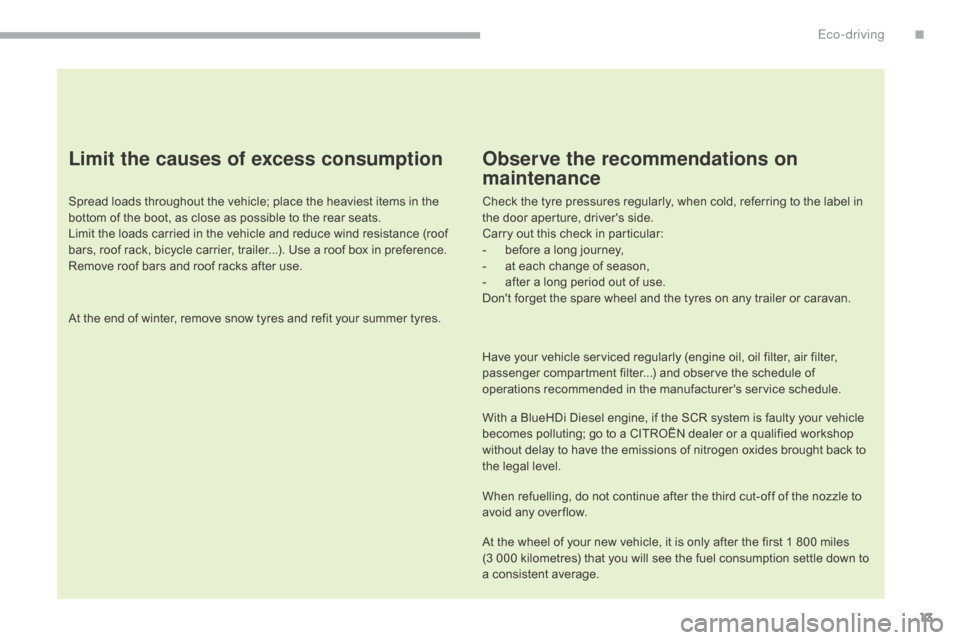
13
C5_EN_CHAP00C_ECO-CONDUITE_ED01-2016.
Limit the causes of excess consumption
Spread loads throughout the vehicle; place the heaviest items in the
bottom of the boot, as close as possible to the rear seats.
Limit the loads carried in the vehicle and reduce wind resistance (roof
bars, roof rack, bicycle carrier, trailer...). Use a roof box in preference.
Remove roof bars and roof racks after use.
At the end of winter, remove snow tyres and refit your summer tyres.
Observe the recommendations on
maintenance
Check the tyre pressures regularly, when cold, referring to the label in
the door aperture, driver's side.
Carry out this check in particular:
-
b
efore a long journey,
-
a
t each change of season,
-
a
fter a long period out of use.
Don't forget the spare wheel and the tyres on any trailer or caravan.
Have your vehicle serviced regularly (engine oil, oil filter, air filter,
passenger compartment filter...) and observe the schedule of
operations recommended in the manufacturer's service schedule.
With a BlueHDi Diesel engine, if the SCR system is faulty your vehicle
becomes polluting; go to a CITROËN dealer or a qualified workshop
without delay to have the emissions of nitrogen oxides brought back to
the legal level.
When refuelling, do not continue after the third cut-off of the nozzle to
avoid any over flow.
At the wheel of your new vehicle, it is only after the first 1 800 miles
(3 000 kilometres) that you will see the fuel consumption settle down to
a consistent average.
.
Eco-driving
Page 16 of 348
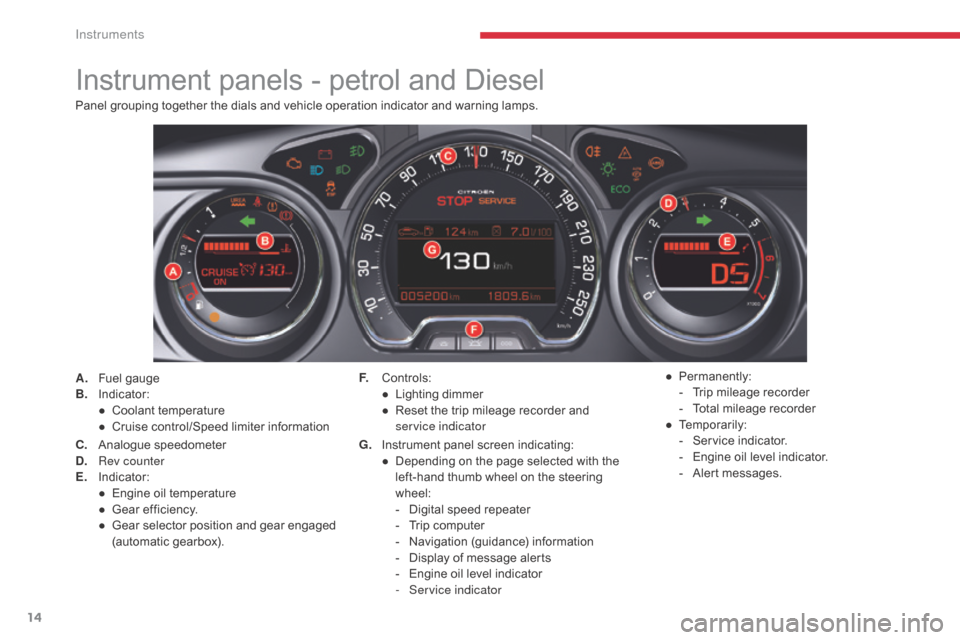
14
C5 _en_Chap01_instruments-bord_ed01-2016
Instrument panels - petrol and Diesel
A. Fuel gauge
B. Indicator:
●
C
oolant temperature
●
C
ruise control/Speed limiter information
C.
A
nalogue speedometer
D.
R
ev counter
E.
I
ndicator:
●
E
ngine oil temperature
●
G
ear efficiency.
●
G
ear selector position and gear engaged
(automatic gearbox). F. C
ontrols:
● L ighting dimmer
●
R
eset the trip mileage recorder and
service indicator
G.
I
nstrument panel screen indicating:
●
D
epending on the page selected with the
left-hand thumb wheel on the steering
wheel:
-
D
igital speed repeater
-
T
rip computer
-
N
avigation (guidance) information
-
D
isplay of message alerts
-
E
ngine oil level indicator
-
S
ervice indicator● P
ermanently:
- T rip mileage recorder
-
T
otal mileage recorder
●
T
emporarily:
-
S
ervice indicator.
-
E
ngine oil level indicator.
-
A
lert messages.
Panel grouping together the dials and vehicle operation indicator and warning lamps.
Instruments
Page 17 of 348
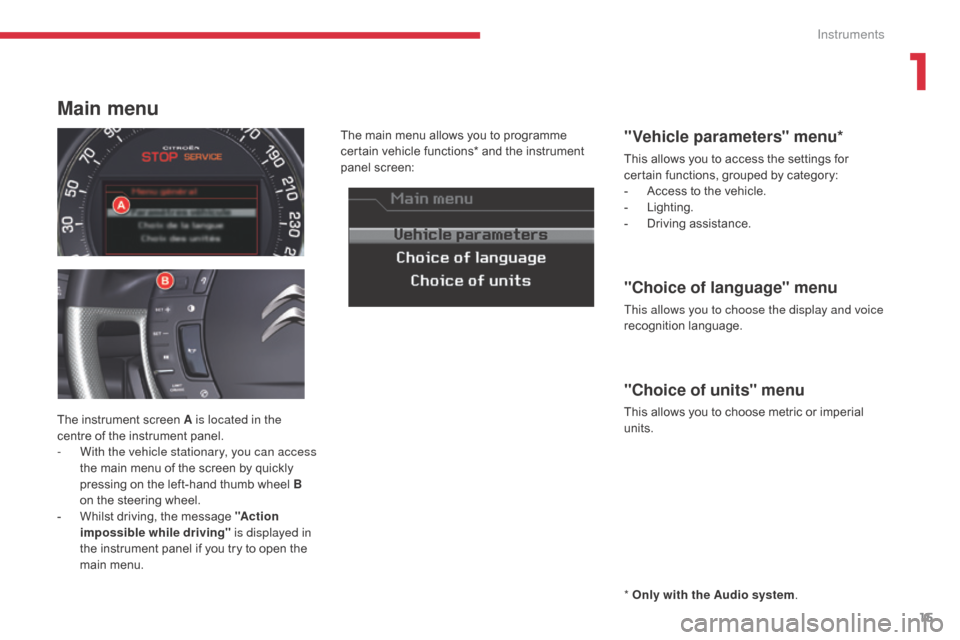
15
C5 _en_Chap01_instruments-bord_ed01-2016
* Only with the Audio system .
The instrument screen A is located in the
centre of the instrument panel.
-
W
ith the vehicle stationary, you can access
the main menu of the screen by quickly
pressing on the left-hand thumb wheel B
on the steering wheel.
-
W
hilst driving, the message "Action
impossible while driving" is displayed in
the instrument panel if you try to open the
main menu.
"Vehicle parameters" menu*
This allows you to access the settings for
certain functions, grouped by category:
-
A
ccess to the vehicle.
-
L
ighting.
-
D
riving assistance.
"Choice of language" menu
This allows you to choose the display and voice
recognition language.
Main menu
The main menu allows you to programme
certain vehicle functions* and the instrument
panel screen:
"Choice of units" menu
This allows you to choose metric or imperial
units.
1
Instruments
Page 18 of 348
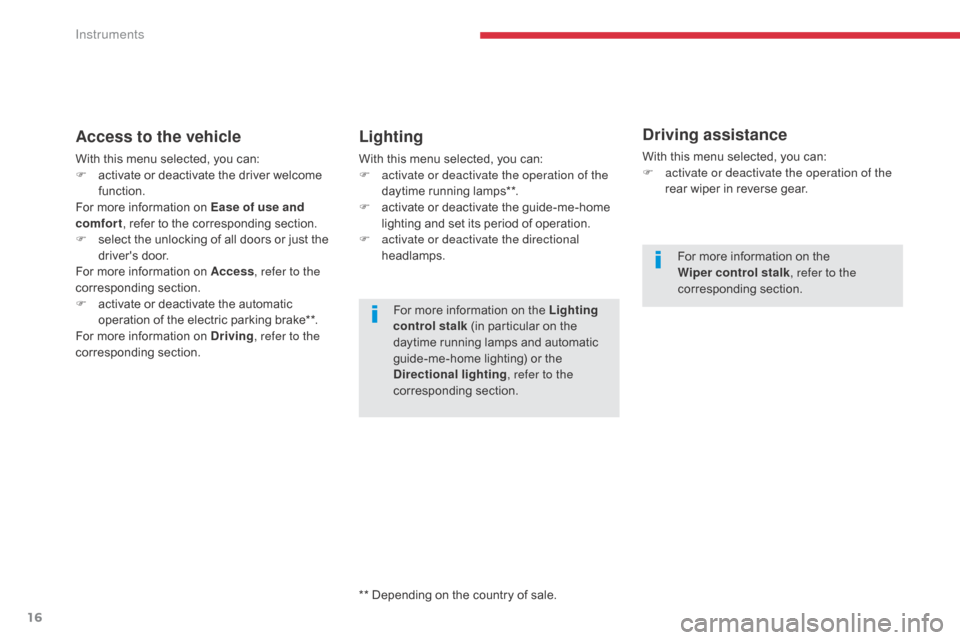
16
C5 _en_Chap01_instruments-bord_ed01-2016
Driving assistance
With this menu selected, you can:
F a ctivate or deactivate the operation of the
rear wiper in reverse gear.
For more information on the
Wiper control stalk , refer to the
corresponding section.
** Depending on the country of sale.
Access to the vehicle
With this menu selected, you can:
F a ctivate or deactivate the driver welcome
function.
For more information on Ease of use and
comfort , refer to the corresponding section.
F
s
elect the unlocking of all doors or just the
driver's door.
For more information on Access , refer to the
corresponding section.
F
a
ctivate or deactivate the automatic
operation of the electric parking brake**.
For more information on Driving , refer to the
corresponding section.
Lighting
With this menu selected, you can:
F a ctivate or deactivate the operation of the
daytime running lamps**.
F
a
ctivate or deactivate the guide-me-home
lighting and set its period of operation.
F
a
ctivate or deactivate the directional
headlamps.
For more information on the Lighting
control stalk (in particular on the
daytime running lamps and automatic
guide-me-home lighting) or the
Directional lighting , refer to the
corresponding section.
Instruments
Page 19 of 348
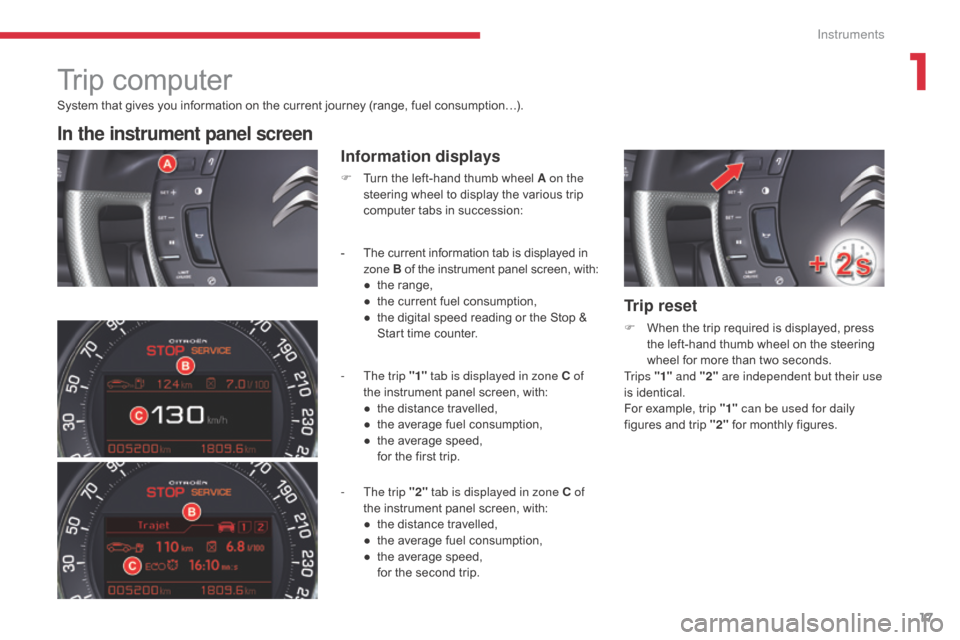
17
C5 _en_Chap01_instruments-bord_ed01-2016
System that gives you information on the current journey (range, fuel consumption…).
In the instrument panel screen
Information displays
F Turn the left-hand thumb wheel A on the steering wheel to display the various trip
computer tabs in succession:
Trip computer
- The current information tab is displayed in zone B of the instrument panel screen, with:
●
t
he range,
●
t
he current fuel consumption,
●
t
he digital speed reading or the Stop &
Start time counter.
-
T
he trip "1" tab is displayed in zone C of
the instrument panel screen, with:
●
t
he distance travelled,
●
t
he average fuel consumption,
●
t
he average speed,
f
or the first trip.
-
T
he trip "2" tab is displayed in zone C of
the instrument panel screen, with:
●
t
he distance travelled,
●
t
he average fuel consumption,
●
t
he average speed,
f
or the second trip.
Trip reset
F When the trip required is displayed, press the left-hand thumb wheel on the steering
wheel for more than two seconds.
Tr i p s "1" and "2" are independent but their use
is identical.
For example, trip "1" can be used for daily
figures and trip "2" for monthly figures.
1
Instruments
Page 20 of 348
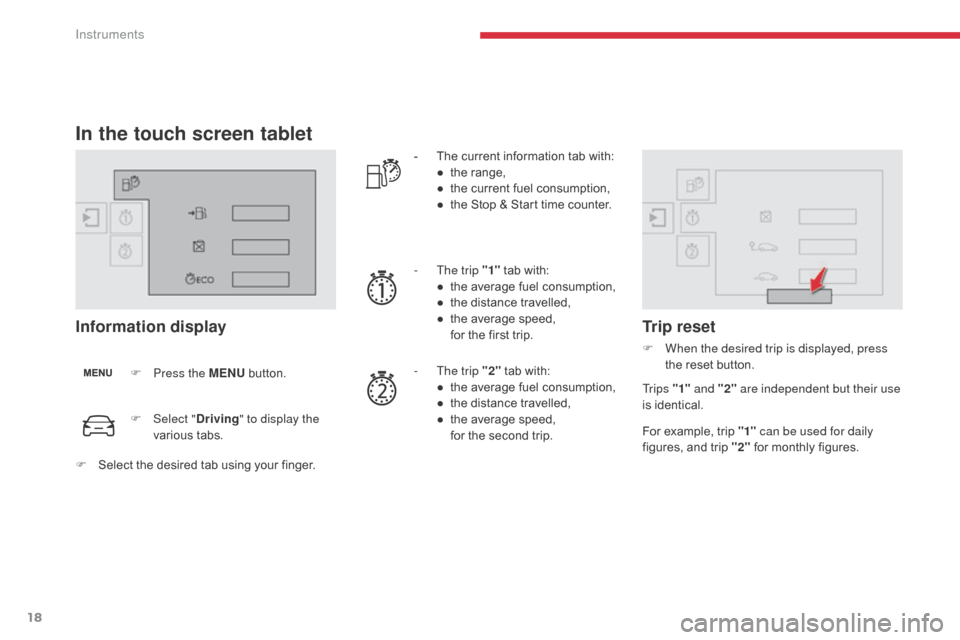
18
C5 _en_Chap01_instruments-bord_ed01-2016
In the touch screen tablet
Information display
F Press the MENU button. -
T
he current information tab with:
●
t
he range,
●
t
he current fuel consumption,
●
t
he Stop & Start time counter.
-
T
he trip "1"
tab with:
●
t
he average fuel consumption,
●
t
he distance travelled,
●
t
he average speed,
f
or the first trip.
- T he trip "2"
tab with:
● t he average fuel consumption,
●
t
he distance travelled,
●
t
he average speed,
f
or the second trip.
Trip reset
F When the desired trip is displayed, press the reset button.
F
Sel
ect " Driving " to display the
various tabs.
F
S
elect the desired tab using your finger. For example, trip "1"
can be used for daily
figures, and trip "2" for monthly figures.
Tr i p s "1"
and "2" are independent but their use
is identical.
Instruments